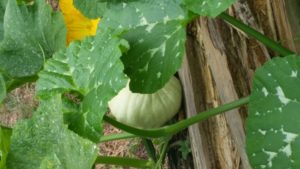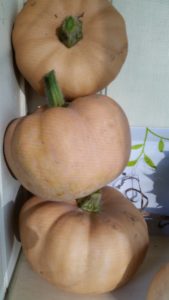Pumpkins are more than Halloween decorations!
My biggest lesson about growing pumpkins
Never grow cucumbers and pumpkins together as they are not good garden bed companions. They will cross-pollinate as they are family and you will end up with not great pumpkins or cucumbers.
Tips for harvesting pumpkins
- Press your nail in the pumpkin skin and if it resists puncture (should be hard), it is ripe.
- Be sure it has reached full colour.
- Cut fruit off the vine carefully with sharp knife pruners (do not tear).
- Allow 3 to 4 inches at the stem to increase the keeping time.
- If your pumpkin makes a hollow sound it is ripe.
- Leave fruit as long as possible on the vine.
- Make sure the vine stem attached to the pumpkin has died and turned brown and woody.

Young pumpkins sheltering under the massive leaves
Storing your pumpkins
- Wash dirt off your pumpkins.
- Store in a cool, dark, dry place.
- Store on a board or on a piece of cardboard.
- If you intend storing a bought pumpkin, buy one with a firm stem attached.
Tips
- Do not worry about frost on the pumpkins. The frost kills the vine and hardens the pumpkin so it keeps better.
- If your growing season is finished, the pumpkins will still ripen and colour up off the vine if placed in a warm sunny spot.
How long will they keep?
Healthy, disease-free pumpkins should last 8 to 12 weeks.

How healthy are pumpkins?
One cup of cooked pumpkin provides 100% of your Vitamin A for the day, 20% of your Vitamin C, Vitamin E, riboflavin, potassium, copper, and manganese and 5% of Thiamine, B6 , folate, niacin and iron.
They are a versatile food. You can add them to stir fries and salads, mash with butter, prepare as a soup or roasted vegetables or use to make delicious deserts.
Download your Low Budget Organic Gardening eBook – Understanding Companion Planting.
To err is human, a pumpkin is divine.